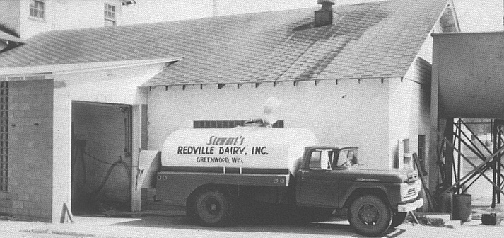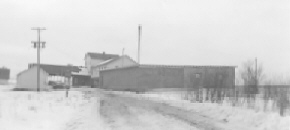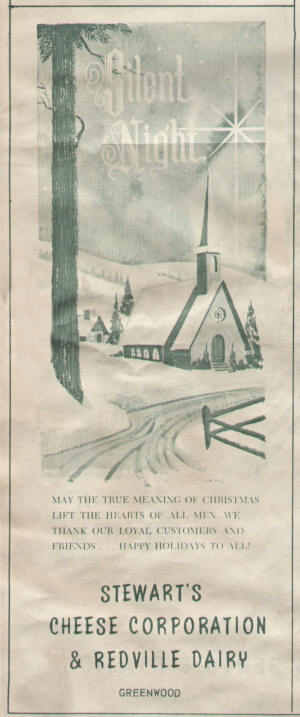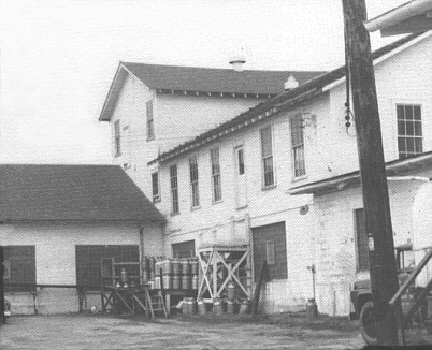Contact: :janet@wiclarkcountyhistory.org
Surnames: Stewart, Bolf, Brux, Bayuk, Dyre, Franz, Goodbrand, Johnson, Markee, Moore, Ormond, Scheuerman, Schwarze, Walter, Welsh
The Stewart Cheese Corporation
Contributed by Mary (Stewart) Humke.

Stewart's Redville Dairy (circa 1960)
The origins of the Stewart Cheese Corporation can be traced back to the small community of Redville, which was located 6 miles north of Withee, Wis., about 1 mile inside Taylor County. At that time Redville consisted of a lumber mill, a general store and the Redville Cheese Factory.
Arthur Stewart bought the cheese factory in 1920 and produced American cheese. During the 1930's he became aware of the demand for Italian cheese, especially in the eastern states. He then hired cheese makers from Italy to come teach him their methods and thus became one of the first to produce Italian cheese in the state of Wisconsin. Thereafter the main product of the factory was Italian cheese, except for the early summer months when the cows first went out on grass and the milk had too much carotene (yellow color) for the light-colored Italian cheese. During those months cheddar cheese was produced. That pattern continued throughout the years.
With the outbreak of World War II the men working in the factory were being drafted into military service and there was a severe shortage of help. It was at that time, 1942, that Arthur asked his brother Wilbur, to help out in the factory. By 1945 the business had outgrown its facilities and a search had begun to find larger quarters, preferably on railroad tracks. A vacant pea canning factory was found in Greenwood, Clark County, on railroad siding. It was purchased and remodeled into a cheese factory. In last 1945 the move was made.
Also, at that time another brother, Robert Stewart, and Harlan Brux, both experienced cheese makers, joined the business and the Stewart Cheese Corporation was formed.
With the new location on railroad siding, shipment of cheese via refrigerated rail cars was now possible, a vast improvement over the previously used over-the-road trucks. The business continued to grow as the demand for Italian cheese grew.
By the late 1940's, their products were beginning to receive recognition. Harlan Brux received the Governor's Trophy for Excellence for their Italian cheese, and for two consecutive years, Wilbur Stewart took top honors for their cheddar at the National Dairy Cattle Congress in Waterloo, Iowa.

Stewart's Redville Dairy in 1951
Many changes took place in the cheese industry between 1920 and 1984. With the advent of the large refrigerated holding tanks, the work week went from 7 days to 5. The range of territory from which the milk was hauled now included 5 counties: Clark, Taylor, Wood, Marathon and Jackson. At the peak of operations between 30 and 35 people were employed, and on occasion, the daily intake of mile reached 120,000 lbs. Since it took 10 lbs. Of mile to produce 1 lb. of cheese, that meant that 12,000 lbs. Of cheese were produced on those days.
In 1984 the business was sold to Professional Managers Corporation, and by 1985 it had ceased to operate.
|
Stewart's Redville Dairy produced over 4 million pounds of Italian Provolone cheese a year (9% of Wisconsin's total output) and approximately 1 million pounds of Cheddar. Producing two varieties provided full-time employment by off-setting the 6 mo. aging process for Provolone. Costly traces of antibiotics from the farms would occasionally show up in the milk and became a "terrific financial drain" because the unprocessed milk would have to be dumped. In 1984, the plant was sold to John Plantan who operated it until July 1985 when it went out of business after he was charged with numerous felonies and two misdemeanors of operating without a license, forgery and embezzlement which led to his imprisonment. (circa 1960) |

The ad above appeared in the 1967 Greenwood Gleaner Christmas Insert.
Memories (Please contact us if you have additional memories to share)
Both of my parents worked at Stewart's Redville Dairy for around 12 years during the 1960's and early 1970's. It was a non-union plant with wages typical of a small towns in the mid-west and very few benefits. I worked there for two summers, as well as on weekends during my senior year of high school. My hourly wage nearly equaled that of my mom and dad, despite their many years of seniority over me. Full-time work amounted to 45 hours per week and I grossed around $240 per month. Preparing, smoking, storing and packaging Provolone Italian Cheese was the normal daily routine. Some of the 100 lb. "rounds" made there were a good foot in diameter and stood some 5 feet high. A plug of cheese was removed for tasting to test it for proper aging. Most of the production was shipped either by rail or by truck to the sizable market in New York. Very few local people, including my family, ate the cheese produced here, because it had a very strong smoky taste. I really enjoy a good piece of provolone cheese today. It just tastes milder than I remember as a kid.
The best time of each day when I worked there was at morning break when we would have some fresh goodies (especially carmel-pecan rolls) from the Greenwood Bakery. My father, Ewald, worked in the smoke room and the shipping department and he often smelled of a strong smoky cheese odor even after bathing. He was a strong man with large hands and the heavy lifting his work required, kept him in good shape. My mother, Sally, molded cheese balls while standing on a cold, damp, cement floor, in a windowless room. I always felt this contributed to the arthritic condition she developed in later life and her eventual need for hip replacement. One of the summers I worked there, I painted the inside of the building. I really got my fill of painting, and it was years before I picked up a paint brush again. Today, I rather enjoy doing it.
After this business changed hands, the new owners were convicted of tax fraud. My brother, Don, was working as an auditor for the Dairy Industry of the State of Wisconsin at the time and he took part in the ultimate investigation. Stan Schwarze--April 2004.
As a young bride my aunt, Leora Dyre, told me she worked in the cheese factories
whenever she wanted something special for the house and the Redville Cheese
Factory of Greenwood, WI was which hired her. She said that neither
the Greenwood Co-op or the Redville Dairy sold anything other than Milk, Cheese,
and Cream. But, that the Greenwood Co-op also was a canning factory. (This
would indicate that some of the products were shipped out.) This would most
likely be in the mid 30's and into the 40's.
She remembered my Uncle Ken, as was typical of the men of that era, was a
bit embarrassed that his Wife had to go "out" to work, so he went into the
Redville Factory and told Art Stewart to treat Aunt Leora "like a baby", thus
regaining his "man of the house" image and pride. Judy Hansen--Sept 2004.
Employees
(Please contact us if you have additional employees to add)
Markee, Lucille
Schwarze, Stan
|
© Every submission is protected by the Digital Millennium Copyright Act of 1998.
Show your appreciation of this freely provided information by not copying it to any other site without our permission.
Become a Clark County History Buff
|
|
A site created and
maintained by the Clark County History Buffs
Webmasters: Leon Konieczny, Tanya Paschke, Janet & Stan Schwarze, James W. Sternitzky,
|

